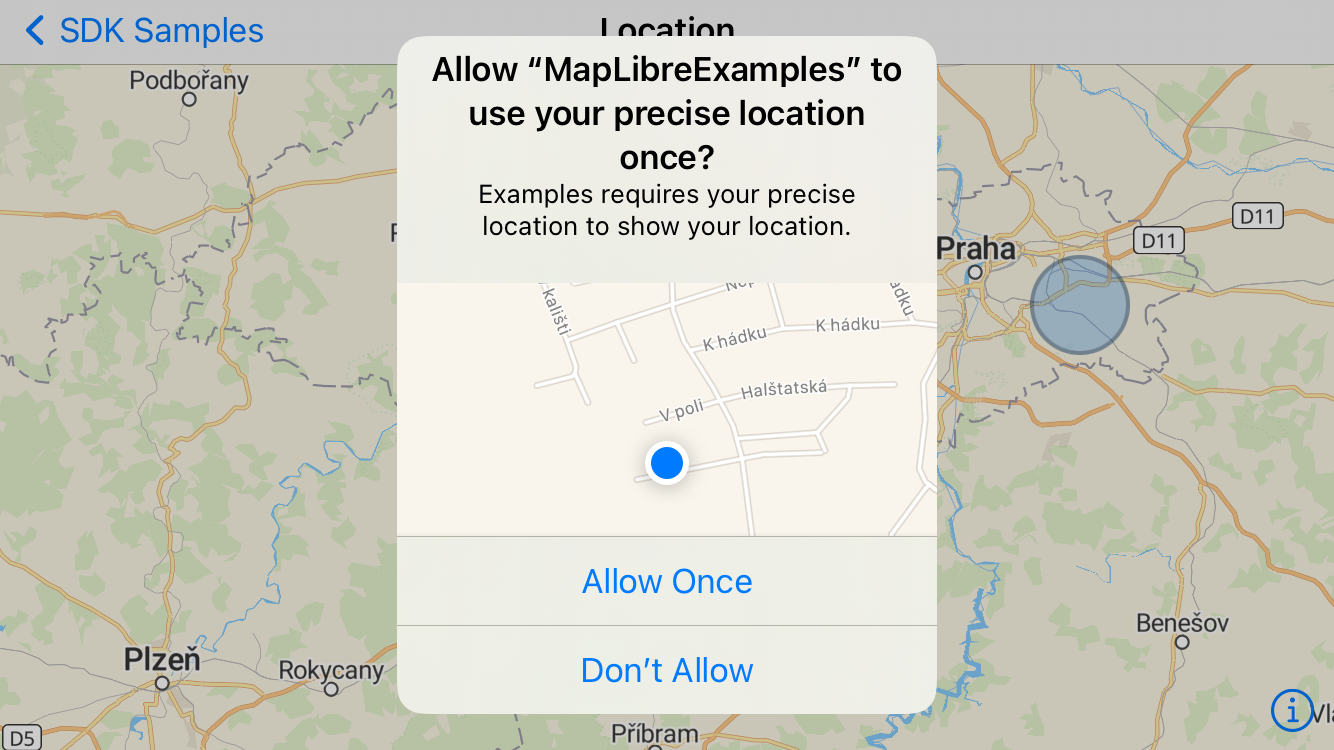User Location

This example demonstrates how to show uer location on the map and request precise location temporarily. You will learn the following:
- How to overlay button on top of the
MapViewand how to coordinate view state between them. - How to setup the app so that it has access to location.
- How to configure the
MapViewso that the user location is shown on the map. - How to temporarily request precise location if user opted out in approximate location.

More information about iOS location manager: https://developer.apple.com/documentation/corelocation/cllocationmanager
Mobile App - Setup the MapView
In order to enable the alert that requests temporary precise location, please add the following into info.plist:
<key>NSLocationTemporaryUsageDescriptionDictionary</key>
<dict>
<key>MGLAccuracyAuthorizationDescription</key>
<string>Examples requires your precise location to show your location.</string>
</dict>
Request location
-
Next, you need to request user location in the
MapViewmapView.showsUserLocation = true
Request Precise Location Temporarily
-
Our example uses SwiftUI. We conditionally add a button for requesting precise location on top of the map view when the current accuracy settings is not precise. So we have two views:
LocationAwareMapViewwhich is wrappingMGLMapViewand makes it possible to use it in SwiftUI. In this view we will useMapViewmethods to request precise location and theMGLMapViewDelegateto respond to event which is raised when location accuracy has been changed.- Second view will contain button used to request precise location when tapped.
We need to coordinate UI state - when the precise location is requested and user accepts it, the
MGLMapViewDelegatewill raisemapViewDidFinishLoadingMapevent and we hide the button. To coordinate the state we use class derived fromObservableObjectwhich contain just a flag indicating if the button should be visible or not.class SharedState: ObservableObject { init(showPreciseButton: Bool) { self.showPreciseButton = showPreciseButton } @Published var showPreciseButton: Bool } -
The method which handles
MGLMapViewDelegateevent raised when accuracy settings changed looks as follows:func mapViewDidFinishLoadingMap(_ mapView: MGLMapView, didChangeLocationManagerAuthorization manager: MGLLocationManager) { guard let accuracySetting = manager.accuracyAuthorization?() else { return } if accuracySetting == .reducedAccuracy { sharedState.showPreciseButton = true; } else { sharedState.showPreciseButton = false; } } -
And the method for requesting precise location :
func requestTemporaryAuth() { guard let mapView = self.mapView else { return } let purposeKey = "MGLAccuracyAuthorizationDescription" mapView.locationManager.requestTemporaryFullAccuracyAuthorization!(withPurposeKey: purposeKey) } -
The full code of the UI:
class LocationAwareMapView: UIViewRepresentable { @ObservedObject var sharedState: SharedState var mapView: MGLMapView? init(_ sharedState: SharedState) { self.sharedState = sharedState } func makeUIView(context: Context) -> MGLMapView { // read the key from property list let mapTilerKey = Helper.getMapTilerkey() Helper.validateKey(mapTilerKey) // Build the style url let styleURL = URL(string: "https://api.maptiler.com/maps/streets-v2/style.json?key=\(mapTilerKey)") // create the mapview let mapView = MGLMapView(frame: .zero, styleURL: styleURL) mapView.autoresizingMask = [.flexibleWidth, .flexibleHeight] mapView.logoView.isHidden = true mapView.showsUserLocation = true // set the map view delegate so that we can respond to events mapView.delegate = context.coordinator // keep map view reference, it will be needed when requesting permissions self.mapView = mapView; return mapView } func updateUIView(_ uiView: MGLMapView, context: Context) {} func makeCoordinator() -> LocationAwareMapView.Coordinator { Coordinator(self, sharedState) } final class Coordinator: NSObject, MGLMapViewDelegate { var control: LocationAwareMapView @ObservedObject var sharedState: SharedState init(_ control: LocationAwareMapView, _ sharedState: SharedState) { self.control = control self.sharedState = sharedState } } @available(iOS 14, *) func mapViewDidFinishLoadingMap(_ mapView: MGLMapView, didChangeLocationManagerAuthorization manager: MGLLocationManager) { guard let accuracySetting = manager.accuracyAuthorization?() else { return } if accuracySetting == .reducedAccuracy { sharedState.showPreciseButton = true; } else { sharedState.showPreciseButton = false; } } @available(iOS 14, *) @objc public func requestTemporaryAuth() { guard let mapView = self.mapView else { return } let purposeKey = "MGLAccuracyAuthorizationDescription" mapView.locationManager.requestTemporaryFullAccuracyAuthorization!(withPurposeKey: purposeKey) } } -
The full code of the wrapped
MapView:struct LocationPermissions: View { @ObservedObject var sharedState: SharedState; var wrappedMapView: LocationAwareMapView; init() { let sharedState = SharedState(showPreciseButton: true) self.wrappedMapView = LocationAwareMapView(sharedState) self.sharedState = sharedState } var body: some View { ZStack { wrappedMapView.navigationTitle("Location") if sharedState.showPreciseButton { VStack { Button( action: {wrappedMapView.requestTemporaryAuth()}, label: {Text("Turn Precise On")}) .background(Color.gray) } } } } }